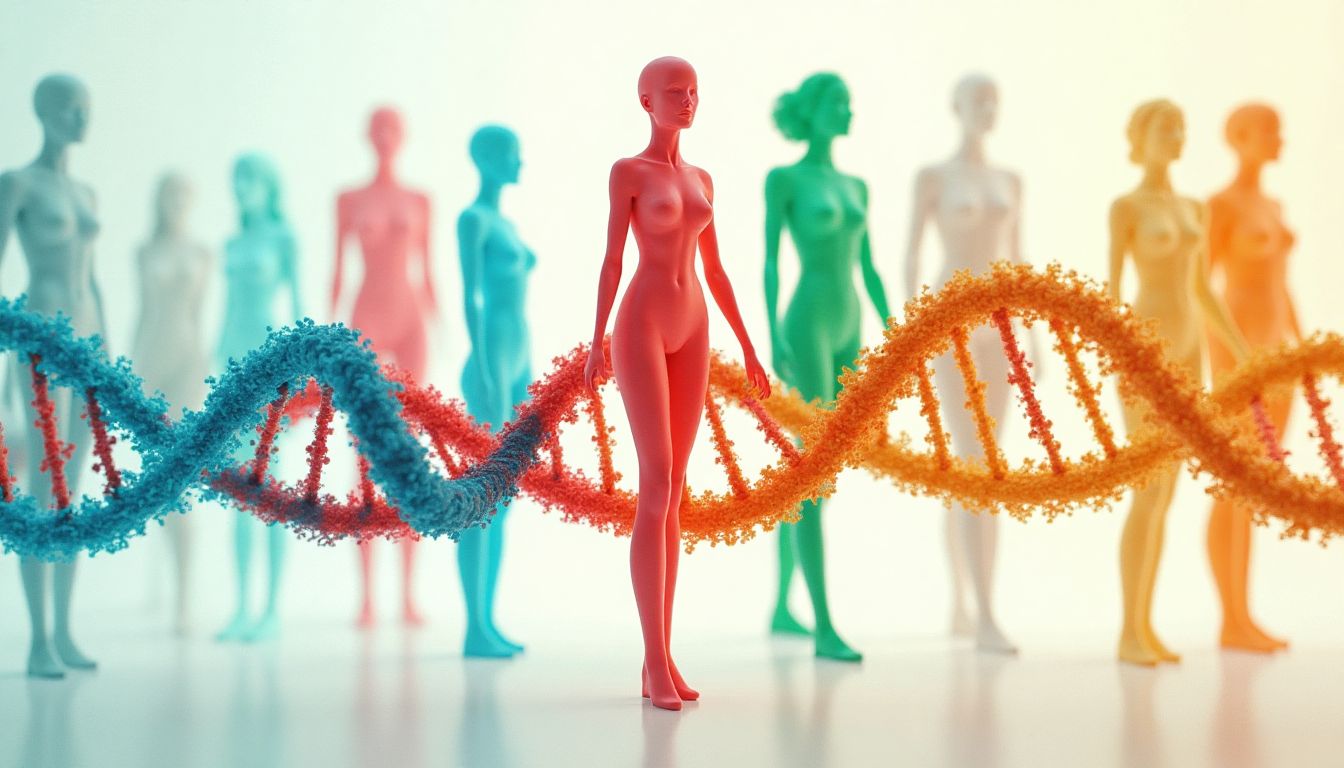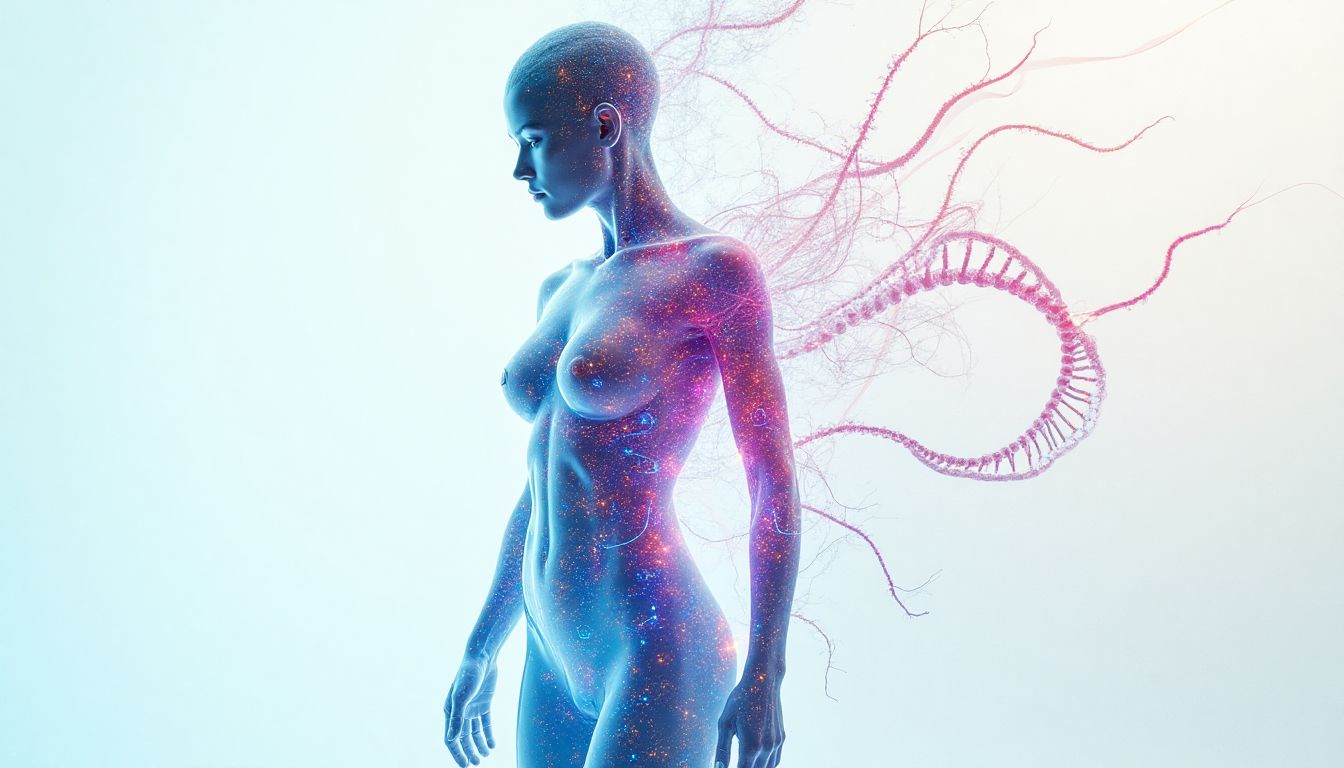Introduction
Every man is the architect of his own fortune – Sallust. In today's world, this saying resonates stronger than ever, especially in the realm of personal aesthetics and health. Our desires to sculpt our physiques and control our body destinies have led us to incredible innovations. With genetic technology making strides reminiscent of science fiction, we're left wondering: could biosculpting be the magical key to unlock the flawless bodies we've always aspired to have?
No longer confined to the dark corners of lab-created superheroes or distant dreams of "perfect" humanity, biosculpting is becoming a buzzword in both medical and aesthetic communities. With famous geneticists like Jennifer Doudna reshaping our understanding of DNA, and futurists like Ray Kurzweil pondering human enhancement, who wouldn't be tempted to put down the dumbbells and press "edit" on our genetic code?
Imagine stepping into a world where you could simply adjust your genetic makeup to shed those extra pounds, just like uninstalling a glitchy app. The possibilities that biosculpting presents are tantalizing, yet they also invite us to consider a host of ethical, societal, and personal implications. The journey ahead is as thrilling as it is terrifying.
Biosculpting represents the fusion of biotechnology and aesthetics, enabling the transformation of one's body through genetic modification rather than traditional exercise or dieting.
The Science Behind Biosculpting
To unravel the magic of biosculpting, we must first peek behind the curtain at the intricate dance of our genes. Imagine the gene as the backstage wizard of your biology play, whispering instructions to your cells on how to build and maintain your body. This is where biosculpting truly begins its bewitching tale.
Genetic Engineering Techniques
Enter the world of CRISPR. While it might sound like the latest snack fad, CRISPR is, in fact, a groundbreaking tool that makes gene editing accessible and precise. This technology, as championed by brilliant minds like Jennifer Doudna Wikipedia profile, allows scientists to snip and swap DNA sequences, much like you would a sentence on your favorite word processor. It’s a scalpel for genetic copy-editing, offering the potential to rewire our biological blueprints.
Gene therapy isn't merely a concept tucked away in the labs of MIT or Cambridge. It’s an evolving reality, promising to tweak those pesky genetic predispositions that make losing that last slice of pizza weight seem Herculean. If you fancy the idea of modifying your genes to trim down rather than trade carbs for cardio, gene therapy could be your golden ticket.
Understanding Body Composition
But changing the body isn’t just about editing genes. It’s about understanding the complex biology of fat and lean mass. Consider your body a finely balanced scale, where fat is stored energy and lean mass is everything from muscles to bones. Metabolism is the proverbial wizard behind the curtain, regulating weight by deciding whether to store or burn energy.
Dr. Michael Apafian, a leading researcher in metabolic processes, notes that tweaking our basic metabolic rate through genetic modifications could one day lead to more personalized diet options that align more closely with our genetic make-up. Imagine a world where your "genetic diet" comes as an easy-to-follow blueprint, no costly personal trainer required!
In essence, biosculpting tantalizes us with the ability to redefine what we know about weight and health. With the boundaries of what's possible continually expanding, this genetic revolution may just allow us to become co-authors of our own evolving bodily stories.
Current Innovations in Body Sculpting
With rapid technological advancements, the world of body sculpting is undergoing unprecedented evolution. While we are nowhere near swapping our exercise hours for genetic tweaks, several innovative methods hint at this biosculpting future.
Non-Invasive Procedures
First up, we have non-invasive procedures. Technologies like CoolSculpting have garnered considerable attention for their ability to freeze away fat cells. Imagine lounging on a plush chair while bits of stubborn body fat simply disappear with the snap of a cold finger! But there's a catch: these procedures are far from magical. While they provide results, it’s typically not a substitute for a disciplined lifestyle. Plus, while ultrasound and radiofrequency techniques add heat to the mix, these methods can only reach so deep without causing discomfort. Think of them as the warm latte of the body contouring world—comforting yet not quite a shot of espresso.
Genetic Testing for Tailored Fitness
Moving from cold to code, genetic testing is making waves as a tool to fine-tune our fitness journeys. Companies like 23andMe are stepping into the arena with personalized insights. Picture the future gym: rather than a buffet of equipment, it's tailored to your genetic predispositions, whispering secrets about your ideal weight loss path. Faster weight loss with fewer bench presses, anyone? Genetic tests provide valuable data, hinting at our body's capacity to metabolize, lose or retain fat, much like a fitness fortune teller (minus the crystal ball and incense). While we wait for the precise intersection of genes and gym time, these insights can craft an individual roadmap for fitness that feels less like a family trip and more like a personal journey.
Ethical and Societal Implications
The notion of biosculpting is not just science fiction; it spurs a realm of ethical quandaries that society must navigate with care. We are trespassing on nature's territory and should perhaps tread lightly.
Ethical Dilemmas of Genetic Modification
Let's talk about the elephant in the lab coat: ethical dilemmas. Genetic modification leads us to a crossroads where possibility meets prudence. The idea of 'playing God' raises questions as old as religion itself. Are we ushering in a new era of genetic elitism, where only the fortunate few can afford a snip and sculpt? And who exactly will regulate these advances? It's a fine line between enhancing the gene pool and diving headfirst into an ethical swamp. Here, regulatory agencies must step in, akin to DNA's own meticulous proofreader, ensuring that allele edits don't transform us into unrecognizable versions of ourselves.
Impact on Body Image and Mental Health
Next, we wade into the murky waters of societal beauty standards and mental health. Altering our physical form with genetic ease has the potential to redefine what it means to be 'beautiful'. Will the Instagram generation face greater pressure to look like digitally-altered movie stars, or will biosculpting alleviate the strain to fit conventional molds? There's a psychological kaleidoscope here: the dizzying mix of newfound confidence and potential identity crisis. Just as the phrase "I'm only human" might become obsolete, so too might our everyday understandings of self-image and identity. The challenge is ensuring that biosculpting becomes a tool for empowerment, rather than a weapon of vanity.
Case Studies: Success Stories and Failures
The road to achieving technological breakthroughs in genomics and biosculpting is as complex as human DNA itself. Understanding real-life applications is vital in exploring this new frontier. Both celebrations of success and moments of failure are opportunities for learning, coaxing the brave into the wild unknown of genetic possibilities. Let's deep-dive into some noteworthy case studies, revealing how the boundaries of body sculpting are being redefined by modern science.
Real-Life Applications
As we tread forward, modern medicine offers a window into the potential capabilities of genetic modification methods. Through examining documented case studies, we notice the full spectrum of possible successes and potential setbacks.
- One promising story involves CRISPR-based therapy aimed to effectuate precise edits in obesity genes. The outcome led to noticeable changes in adipose tissue metabolism and distributed body fat differently while respecting core health parameters. While the journey is ongoing, the wide grin of success already shows.
- Further north, UK researchers recently observed success with gene therapy targeting muscle growth. While initially intended for muscular dystrophy, it illuminated the horizon for muscular augmentation, staggeringly welcomed by dermal clinics worldwide.
Lessons Learned from Gene Therapy Trials
Every hero's journey has its dragon to slay. Similarly, the gene therapy landscape isn't absent of failures—offering lessons to meticulously note, making success stories even sweeter.
- Underlining the bitter lessons is a CRISPR gene therapy trial that faced unforeseen complications involving immune responses. Despite the initial hype, potential side-effects require cautious assessment before heralding victory.
- The renowned University of Pennsylvania, trailblazing in genetic sciences, flagged issues during gene modification on animals—a humble message that patience remains essential amid these genetic pursuits.
Brimming with mixed results, these technical odysseys reveal both cautionary and celebratory tales, weaving a narrative rich with insights and aspirations.
Future of Biosculpting in Medicine and Fitness
As the clock of progress tick-tocks closer to embracing wide-scale biosculpting, its evolution signals profound effects beyond sculpted abs and cellulite-free skin. Projecting into the future, we discover realms where biosculpting dovetails seamlessly into medicine and fitness, an orchestral symphony composed with genetic precision.
Integration into Medical Practices
Imagine stepping into a world where healthcare dialogues echo with discussions beyond lifestyle, into the very core of genetic coding. Biosculpting posits a vast spectrum of potential within medical clinics exploring the virtues of genetics for comprehensive well-being.
- Treating obesity and related health issues might become significantly easier, thanks to genetic tweaks which recalibrate metabolism and boost nutrient processing.
- Under the watchful gaze of healthcare providers, who hold ethical and operative vigilance, biosculpting could help resolve several health scenarios ingrained in bodily mechanisms, fortifying healthcare by combining visual allure with tangible fitness goals.
Commercialization and Market Dynamics
The biosculpting market forecasts a dynamic trajectory, hankering the arrival of entrepreneurs hungry to innovate products accessible for the public. In this ~futuristic agora~, market leaders and fledgling start-ups might engage in cerebral handshakes while transforming our experience of personal care.
- Awash with vitality and eagerness, the swaying pendulum of potential promises market growth across the body sculpting industry, heralding startups as pioneers of this medical and fitness convergence.
- Traditional gyms, along with diet industries, may find themselves vying for attention in a landscape dim-lit by evolved genetics, reshaping business dynamics and sparking fresh dialogues on fitness optimization.
Exploring undiscovered territories, biosculpting presents the most critical reflection on human nature—allowing us to accent our existence uniquely and ambitiously.
AI Solutions: How Would AI Tackle This Issue?
If artificial intelligence were tasked with solving the challenges of biosculpting, its approach would be multifaceted and highly sophisticated. The integration of AI into biosculpting could reshape how we understand genetics, body composition, and personal health—ushering in an era of customized body enhancement like never before.
Data Analysis and Predictive Modelling
- Utilizing AI algorithms to analyze extensive genetic data sets can lead to improved understanding and prediction of individual responses to biosculpting techniques. Supercomputers and deep learning could analyze patterns in genetic predispositions, metabolism, and fat storage.
- Implementing machine learning models that dynamically adapt based on trial results and genetic variations might significantly enhance the effectiveness of biosculpting methods. Such systems could predict successful outcomes tailored to individual genetic make-up.
Personalized Health Applications
- Developing AI-driven applications that create customized fitness and nutritional plans based on genetic data could revolutionize individual approach to health. These apps could analyze user data and provide real-time adjustments, ensuring that each user maximizes their biosculpting potential.
- Integrating AI into wearable technology could monitor physiological data in real-time, allowing for immediate adjustments to fitness or diet regimens, thereby promoting optimal conditions for biosculpting efforts.
Collaborative Research Framework
- Building a network of partnerships between tech giants such as [Google DeepMind](https://deepmind.com/) and [MIT Media Lab](https://www.media.mit.edu/) focused on collaborative biosculpting research. Engaging institutions in joint ventures can pool resources for robust data analysis and innovative solutions.
- Creating open-source platforms where researchers can share findings, resources, and algorithms would accelerate advancements in biosculpting technology. This collaborative environment could catalyze unexpected breakthroughs across multiple fields.
Actions Schedule/Roadmap (Day 1 to Year 2)
Day 1: Formulate Core Team
Gather a diverse team comprising geneticists, AI specialists, bioethicists, fitness experts, and data analysts. This team will set forth the foundational research objectives, ensuring a well-rounded perspective in all project phases.
Day 2: Conduct Literature Review
Engage with existing scientific literature on genetic editing techniques including [CRISPR](https://www.crisprmedicinenews.com/) and gene therapy, top journal articles, and recent advancements in AI applications in health technologies. This review will inform the initial phases of research.
Day 3: Develop Research Protocols
Create a comprehensive research plan focusing on potential biosculpting methods. This plan should encompass safety standards, ethical academic scrutiny, and a regulatory pathway for research approvals, ensuring responsible conduct.
Week 1: Foster Institutional Partnerships
Forge partnerships with leading institutions such as [Stanford University](https://www.stanford.edu/) and [Harvard Medical School](https://hms.harvard.edu/) to gain insights, access advanced technologies, and utilize their rich research infrastructure.
Month 1: Initial Pilot Studies
Begin pilot studies evaluating existing biosculpting techniques on animal models. This foundational research will clarify the applications of existing technologies, paving the way for eventual human trials.
Month 2: Ethical Review Process
Submit research protocols to ethical committees, like the [National Institutes of Health (NIH)](https://www.nih.gov/), for approval. This step will establish a framework for ethical governance, ensuring transparency and public trust in future developments.
Month 3: Develop AI Analytical Framework
Engage AI specialists to create a predictive model analyzing real-time genetic data. Using technologies developed by companies like [IBM Watson](https://www.ibm.com/watson), this model will facilitate detailed assessments of biosculpting outcomes.
Year 1: Undertake Human Trials
Launch initial human trials, focusing on key demographics and exploring varying genetic backgrounds. Collect comprehensive data surrounding safety, effectiveness, and user experience, while ensuring robust ethical compliance.
Year 1.5: Optimize Applications
Assess pilot study results, focusing on participant feedback and outcomes. Use insights to adapt and refine personalized biosculpting strategies, ensuring user confidence and safety.
Year 2: Market Implementation
Finalize commercialization strategies for biosculpting products and services, ensuring that healthcare input remains primary. Prepare community engagement strategies, emphasizing education as more public interest in the technology arises.
Conclusion: Embracing the Future of Biosculpting
As we stand before a transformative age marked by biosculpting, we must navigate the exhilarating opportunities and daunting responsibilities that come with the ability to reshape our very biology. The dream of achieving the ideal physique without the limitations of traditional diet and exercise methods is no longer a fantasy; it is evolving into a tangible reality. Yet, as we venture further into this brave new world, we must remain vigilant guardians of ethical standards, societal implications, and the psychological impacts on identity and self-perception.
Every step forward must be grounded in rigorous scientific inquiry and ethical considerations. It demands that we tread thoughtfully, ensuring that advancements in genetic technologies serve us all equitably. The future of biosculpting beckons- offering hope, new possibilities, and pathways for personal and collective growth. It is our shared responsibility to embrace these innovations with compassion, purpose, and a commitment to preserving the rich complexity of what it means to be human. Together, let us step boldly into a future where the potential for transformation nourishes not just our bodies, but the very fabric of society as well.
Frequently Asked Questions (FAQ) about Biosculpting
What is biosculpting?
Biosculpting is a cutting-edge field that uses genetic technologies to help people shape their bodies without traditional exercise or dieting. It focuses on using genetic engineering to modify body composition and enhance physical traits according to personal desires.
How does biosculpting work?
The process involves altering genes related to fat storage, muscle growth, and metabolism. Techniques like CRISPR, a powerful gene-editing technology, allow scientists to make precise changes to our DNA. Imagine being able to tell your body to burn more fat or build more muscles without breaking a sweat!
How is biosculpting different from traditional weight loss methods?
Unlike traditional methods like dieting and exercising, which take time and effort, biosculpting offers the potential for quicker results. It focuses on changing your genes to achieve the desired body shape, rather than relying solely on lifestyle changes. It's like fast-tracking your transformation!
Is biosculpting safe?
Safety is a major concern when it comes to biosculpting. Just like any medical procedure, it needs to be tested thoroughly. Regulatory agencies, such as the U.S. Food and Drug Administration (FDA), will have strict guidelines that need to be followed to ensure it is safe for everyone who wants to try it.
What are the potential risks of biosculpting?
Although the idea of biosculpting sounds exciting, there are possible risks involved:
- Unintended side effects: Changes in genes might lead to unexpected health issues.
- Ethical concerns: Some people worry about 'playing God' and creating inequalities.
- Regulatory issues: Lack of clear rules can lead to safety problems.
What ethical issues surround biosculpting?
Before biosculpting becomes mainstream, we must consider its ethical implications. Some of the biggest questions include:
- Genetic elitism: Will only wealthy people have access to these technologies?
- Informed consent: Are people fully aware of what they're signing up for?
- Body image: How might this change our views on beauty and self-worth?
How can AI improve biosculpting?
Artificial Intelligence (AI) could play a big role in improving biosculpting techniques. It can help:
- Analyze data from genetic tests to find the best approach for each individual.
- Predict outcomes for different procedures and tailor them to specific needs.
By harnessing AI, scientists can make biosculpting more effective and personalized for everyone!
When will biosculpting be available to the public?
The timeline for biosculpting to be widely available depends on ongoing research and testing. Many experts believe it might be available within the next decade but will require careful evaluations and regulations.
Are there any success stories of biosculpting?
As this technology develops, we'll likely hear about exciting success stories. However, it's essential to keep in mind that real-world applications are still in early stages. Future studies will help shape our understanding of the benefits and challenges of biosculpting.
What are some of the current innovations in body sculpting?
Before biosculpting becomes mainstream, we have some amazing non-invasive methods available, such as:
- CoolSculpting - A technique that freezes fat cells, helping to reduce stubborn fat areas.
- Ultrasound and radiofrequency treatments - These technologies target fat and skin tightening without surgery.
How do I stay informed about biosculpting advancements?
Staying updated is easy! Follow reliable sources in the fields of genetics and wellness, such as the Nature journal or the GenomeWeb website, to learn about the latest developments in biosculpting and related technologies.
Wait! There's more...check out our gripping short story that continues the journey: The Last Sanctuary
Disclaimer: This article may contain affiliate links. If you click on these links and make a purchase, we may receive a commission at no additional cost to you. Our recommendations and reviews are always independent and objective, aiming to provide you with the best information and resources.
Get Exclusive Stories, Photos, Art & Offers - Subscribe Today!





























Post Comment
You must be logged in to post a comment.